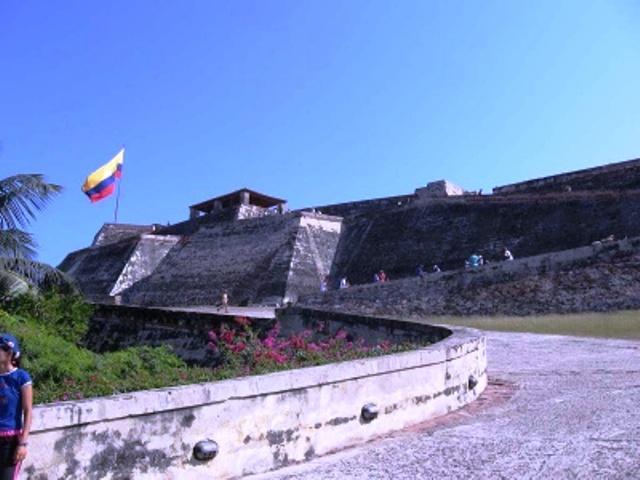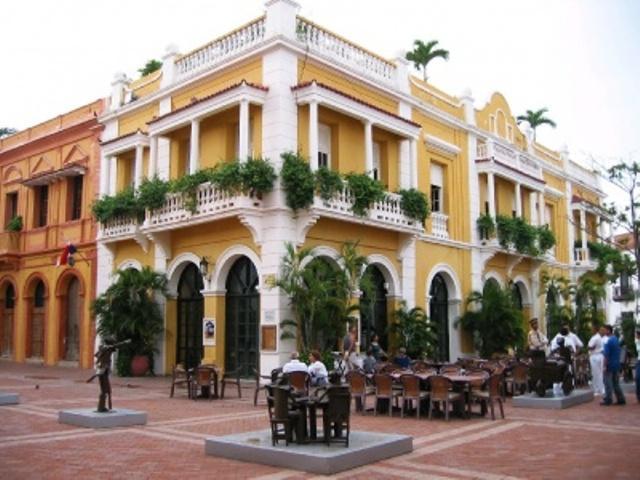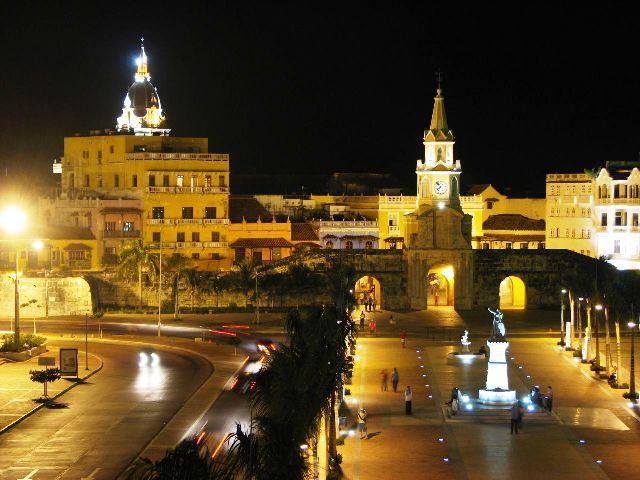Cartagena de Indias, Bolivar, Colombia
Suggest Place to Visit
3822
Track to location with GPS |
 |
The history of Cartagena de Indias is divided into several periods that have as their starting point the arrival of Christopher Columbus to the American continent. It begins with the period before the arrival of the Spanish or pre-Columbian empire, a time of which there are hardly any cultural traces, and continues with the discovery and colonization by Spain (which constitutes the most splendid period of this city), the independence movements , the republican era, civil strife, to cover recent history.
Precolumbian era
The bay of Cartagena was inhabited by the Calamari nations of the Karib group, called Caribs by the Spanish. A quote from the time described the indigenous people like this:
´´Calamari which in the indigenous language meant crab and which Heredia and its people Spanishized by simply calling it Calamar, was the name with which the natives called a village located in the last fold of the bay of Cartagena towards the north. Straw town with roofs that almost reached the ground, surrounded by a strong circular palisade and thorny trees crowned with skulls whose inhabitants were mired in secular barbarism, but also in absolute freedom.´´
Hispanic era
During the Spanish colonial era it was one of the most important ports in America. From Cartagena came the greatest wealth that the Spanish Crown needed for the maintenance of that gigantic conquering company, by sea routes that ended in the Spanish ports of Cartagena, Cádiz and Seville. It was also the largest trading point for black slaves brought from the African continent.
The first Spaniard to arrive in what is now Cartagena de Indias was Rodrigo de Bastidas, a notary in Seville. Bastidas had participated in one of the first voyages of the discoverer Christopher Columbus to America. Initially the area was baptized with the name of Golfo de Barú by Bastidas himself. In 1503, the Cantabrian cosmographer Juan de la Cosa asked the Queen of Spain Isabel la Católica to change the name of Golfo de Barú to ´´Bahía de Cartagena´´. The Queen then ordered the name to be changed to Royal Provision. The name of Cartagena was given due to the similarity of the bay with that of Cartagena de Levante in Spain and was given by agreement between Juan de la Cosa and the Queen herself.
The city was founded on June 1, 1533 by Pedro de Heredia and the soldiers who accompanied him, many of them originally from Andalusia and Extremadura. The capitulation that authorized him said: "I give you license and power so that you can build and build a fortress in said province that is convenient for the defense of the Spaniards who reside there, in the part that seems best to you." On Calamarí Island, where there was an indigenous settlement, Heredia established his headquarters and proceeded to name the Cabildo and map out the city. In 1538, the Crown authorized the general distribution of Indians among the neighbors, and assessed the tributes. Cartagena is converted into a colonial society of encomenderos. The port was gaining importance thanks to its bay protected by the Spanish military, the construction of forts and walls and its proximity to Panama City, another important Spanish port. In the following years Heredia was imprisoned for crimes against the Sinú people and, later, sentenced to death. Contrary to what is believed, the Crown already watched over human rights according to the "Laws of the Indies". But Heredia managed to escape to Spain. It would be of no use to him, since he died when his ship sank in the middle of the ocean.
The Catholic Church established the Inquisition to ensure the power of the Catholic faith, given the propensity of slaves to pagan cults that included forms of witchcraft.
Cartagena de Indias was attacked numerous times by pirates and English (Francis Drake, 1586), French and Dutch troops. For this reason, King Felipe II entrusted the mission to Field Marshal Luis de Tejada and the Italian engineer Bautista Antonelli to build 11 km of walls and forts that served as defense in the 17th and 18th centuries. [18] The fortification is the most complete in South America and was completed in 1796 by the Spanish engineer Don Antonio de Arévalo. A system of zones allowed to protect the city divided into five neighborhoods: Santa Catalina with the cathedral and numerous Andalusian-style palaces; Santo Toribio, where the merchants and the petty bourgeoisie lived; La Merced, where the headquarters of the fixed battalion was located; San Sebastian, a neighborhood of modest one-story houses and, finally, the suburb of Getsemaní, a neighborhood of artisans and port workers.
In March 1741 the city was besieged by the troops of the English Admiral Edward Vernon, who arrived with a squadron of 186 ships and 23,600 men (the largest fleet assembled until then and which would not be surpassed until the Normandy Landing) against 6 ships. and 3,000 men, who finally had to withdraw after the failure of the siege, repelled at first by the then Commander General Blas de Lezo and finally expelled by the colonel of engineers Carlos Suillars de Desnaux and his men.
On November 11, 1811, Cartagena became the second territory to declare absolute independence from Spain in present-day Colombia, after Santa Cruz de Mompox on August 6, 1810. Then on August 20, 1815, in the early years of Independence from Spain, Cartagena de Indias was the object of a reconquest campaign led by the Spanish military man Pablo Morillo, who established a state of siege against the insurgents entrenched in the city. This situation continued for three months, with which said insurgents suffered hunger, epidemics and mortality. The desperate rebels decided to face the Spanish to the death. As a consequence of this episode, the city would receive the title of ´´Heroic City´´.
20th century and development are synonymous in the history of Cartagena. At the dawn of the new century, the city underwent a phase of profound economic, social, political and cultural transformations. Industrial development and the consolidation of a business elite, represented by merchants, bankers and industrialists associated with foreign migration, marked this transformation that was reflected in urban planning, art, literature, customs and the cultural identity of Cartagena. Cartagena was not touched by the civil wars that shook Colombia. Peace and the opening of the railroad that linked the city with the port of Calamar (Colombia) on the Magdalena River, allowed the bay to regain its strategic role as a commercial port on the Caribbean.
Cartagena de Indias or Cartagena, is the capital of the department of Bolívar, Colombia, and was founded in the year 1533 by Don Pedro de Heredia. It is the main tourist destination in Colombia and the fifth city in the country in population after Bogotá, Medellín, Cali and Barranquilla. Since 1991 Cartagena is a Tourist and Cultural District. The city is located on the shores of the Caribbean Sea and is one of the most important tourist epicenters in Colombia, as well as the second most important urban center on the Colombian Caribbean Coast, after Barranquilla.
From its foundation in the 16th century and throughout the Spanish colonial era, Cartagena de Indias was one of the most important ports in America. On November 11, 1811, Cartagena declared itself independent from Spain. This day is a national holiday in Colombia and in the city it is celebrated for 4 days known as the ´´Fiestas de Independencia´´. Since 1933, November 11 serves as the day for the election and coronation of Miss Colombia in the National Beauty Contest.
Over time, Cartagena has developed its urban area, preserving the historic center and becoming one of the most important ports in Colombia, as well as a famous tourist destination. Its total head population is 892,545 and together with its area or sphere of influence it houses a total population of 1,188,078 that includes the municipalities of Turbaco, Arjona, Turbana, Santa Rosa, Santa Catalina, Clemencia, Maria La Baja, Mahates, San Estanislao, Arenal and Villanueva being Cartagena its nucleus. Its historic center, the "Walled City", was declared a National Heritage Site of Colombia in 1959 and a World Heritage Site by UNESCO in 1984. In 2007 its Military Architecture was awarded as the fourth wonder of Colombia.
The city of Cartagena is located in the north of the department of Bolívar on the shore of the Caribbean Sea. It is located at 10º 25´ 30´´ north latitude and 15º 32´ 25´´ west longitude with respect to the Meridian of Greenwich. It is located in a typical, rugged and irregular coastal area, made up of geological processes related to the sea. Among the most important geographical features of the city are the island formations of Barú and Tierrabomba along with other smaller islands, the Rosario Archipelago, the Bay of Cartagena, the Bay of Barbacoas, and coastal lagoons such as the Ciénaga de Tesca or de la Virgen. . The area is also an area of marine and fluvial confluence due to the presence of the mouths of the Canal del Dique that generate delta-type formations in the Bay of Cartagena and Barbacoas. In the city, the formation of La Popa stands out, with an antiquity between the Upper Pliocene and the Lower Pleistocene. It is composed of rocks and corals, it is presented in the form of elongated hills, strong and medium slopes where alluvial fans, gullies, escarpments and cliffs are found. The flat and low areas near the coastal shoreline are made up of deposits of quaternary origin that constitute breakwaters, littoral ridges and deltas governed by littoral drift.
Cartagena de Indias has an average humidity of around 90%, with the rainy season typically between April-May and October-November.
It is noteworthy that although the climate tends to be hot generally all year round, it is always windy, being a factor to take into account to make the climate bearable and even comfortable. The months of November to February are the windiest of the year, resulting in extra cooling, at the temperatures of those northern winter months.
Cartagena de Indias has the blessing that while it is a maritime Caribbean city, it is never touched by hurricanes that do affect other Caribbean capitals such as Havana, Santo Domingo, Cancun, Kingston, San Juan. The reason for this is that the city is in the Caribbean but quite southern, and isolated from the fierce hurricane currents. The last hurricane to hit the city was Joanne in 1988, which was weakened after passing through Puerto Rico.
Cartagena de Indias has a solid multi-faceted economy thanks to the fact that it has a diversified productive structure in sectors such as industry, tourism, trade and logistics for international maritime trade that is facilitated due to its strategic location on the Caribbean Sea to the north of South America and in the center of the American continent. In recent years, during the diversification of its economy, the petrochemical sector, the processing of industrial products and international tourism have stood out. It is currently the fourth city in industrial production in Colombia. Since the beginning of the 21st century the city has been experiencing growth in the construction sector.
Industry is one of the main economic activities of the city, contributing 10% of the jobs. One of the most prominent industrial activities is the manufacture of chemicals and products derived from oil refining. Most industries are located in the Mamonal Industrial Park, considered one of the most important Industrial Zones in Colombia, in which there are 136 large and medium-sized companies that generate about 8.04% of the country's industrial gross domestic product ( 2004) and the Industrial Zone of El Bosque where the main free zones of the several that the city has are located.
José Fernández Library Madrid University of Cartagena: It began in 1821 when the university was known as the ´´Universidad del Magdalena y Ithsmus´´. It serves mainly the students and faculty of this university, but also for the general public.
Bartolomé Calvo Library: founded in 1843 and established in its current place in 1900, it is one of the main libraries on the Caribbean Coast and the largest in the city located on Calle de la Inquisición in the Historic Center.
Library of the Academy of History of Cartagena de Indias: inaugurated in 1903, but many of its books date back more than a century before donations from members and benefactors. Its entry is more restricted due to the care that old books require, but it can be requested at the Academy office in Plaza de Bolívar.
Library of the Technological University of Bolívar: inaugurated in 1985, its strength are its sections on engineering and electronics, standing out in this academic field.
Library of the Training Center of Spanish Cooperation: it has been providing its services since 1993 and houses bibliographic material specialized in Spanish Literature, History of Spain-America and Art, among others. It is public in nature and open to all participants in the International Courses and Seminars held at the Training Center, visitors and users.
Museums and cultural centers
Gold Museum, Cartagena Modern Art Museum, Rafael Núñez House Museum, Caribbean Naval Museum, San Pedro Claver Museum, Bolivar House Museum, German Colombo Cultural House, Spain House, Cartagena Cultural Center for Spanish Cooperation, Colombo American Center, Casa del Marqués Valdehoyos, Palace of the Inquisition, School of Fine Arts of Cartagena, Colombian Alliance Française of Cartagena, International Film Festival Venue, Cultural Hall ´´Domingo López Escauriaza´´.
Theaters
Heredia Adolfo Mejía Theater: it is the main theater of the city which was built in 1911 to commemorate the centenary of the independence of Cartagena. Its architecture was in charge of Don Felipe Jaspe inspired by the Tacón Theater in Havana, built in the shape of a horseshoe with boxes and divided balconies. The ceiling and curtain were works by the Cartagena artist Enrique Grau. Events such as the Cartagena International Music Festival and the Hay Festival literary meeting take place there.
Recula del Ovejo Theater Hall: Arranged with the Ministry of Culture and the Society for Public Improvement of Cartagena, in this venue the Cartagena Theater Season is held, organized by the same theater players of the city in an effort in which several modalities such as programming for adults, children's theater, programming in communities, stage installations, exhibition of posters, posters and cartoons and meeting of theater delegates from the Coast, with a view to the V National Theater Congress.
Music
Since long before the generalization of the musical expression known as Champeta, Cartagena has distinguished itself for being the cradle of excellent musicians and the source of various musical expressions. The mapalé, the cumbia and the son, among others, are airs that have found an environment conducive to their development in the city.
Among the Cartagena musicians of lineage and heritage, it is worth highlighting Sofronín Martínez, Rufo Garrido, Joe Arroyo and Juan Carlos Coronel. Currently the city is represented internationally by the Kalamarí Big Band.
La Champeta is the name of what is considered by some to be the main original musical culture of the city of Cartagena; named this way for more than 20 years, which would later translate into a type of dance and finally a musical genre, both of which have been criticized for having a high erotic content, bordering on obscenity. Champeta is a word that in its beginnings was born as a discriminatory qualifier for the Afro-descendant inhabitants of Cartagena, due to their daily relationship with the knife or machetillo of the same name (champeta). In ancient times, the adjective ´´champetudo´´ had an offensive connotation and was used to refer disparagingly to the poorest and uneducated population. Now it is used to indicate an indigenous, valid and valued culture or even to refer to someone related to the musical genre Champeta Criolla.
The champeta inspired by European-African music is of Colombian origin from Cartagena de Indias, and from San Basilio de Palenque.
Comments
We don´t have yet any comments about:
Cartagena de Indias
Cartagena de Indias
Be the first to leave a comment as it is very important to inform other people
Outros locais a visitar
Within a radius of 20 km from:Cartagena de Indias
San Felipe de Barajas Castle |
| 4,1 Km |
 |
Casa Plazuela San Pedro Claver |
| 5,1 Km |
 |
Hotel reservation near Cartagena de Indias within a radius of 20 km
Why to book with TOURISTIC ROUTES
The best prices
Our partnerships with the world´s largest operators offer research on the best market prices.
More options
At Rotas Turisticos you can book the hotel, buy the air ticket, book the transfer from the airport to the hotel and vice versa, book the local excursions, rent the car, take travel insurance and consult the places to visit and where to go.
Holiday Tips & Destinations
Hundreds of holiday destinations with all the options that allow you to easily choose the destination that best suits your dream vacation.
TOURISTIC ROUTES
Links






